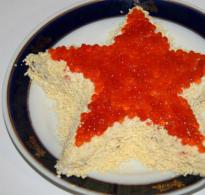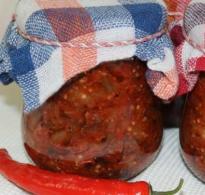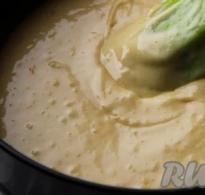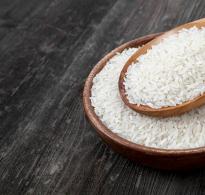How to cook vegetable pilaf for the winter. Pilaf for the winter - a step-by-step recipe
Mom always made large-scale preparations for the winter. She proudly reported on the work done: “Imagine, I rolled up 567 jars...” Everything that grew at the dacha was salted, pickled, rolled into jars or frozen in the freezer. I loved tasting these preparations. Every year, more and more new recipes appeared in my mother’s piggy bank, and she immediately strove to bring them to life. Now my mother cannot cope with such a volume - she is not the same age. We have to take over the baton. Today's recipe - vegetable pilaf.
1.5 cups of rice, 0.5 kg of sweet peppers (for beauty it is better to take multi-colored ones), 0.5 kg of carrots, 0.5 kg of onions, 2 ripe tomatoes, 1 tbsp. l. sugar, 325 g vegetable oil, 1 tbsp. l. salt, 1 bay leaf.

I wash the jars, dry them and put them in the oven, heated to 50-70 degrees for 15 minutes. I wash and peel the vegetables. I cut the onion into half rings. Pepper into strips about 2-3 mm thick. I grate the carrots on a coarse grater.

I puree the tomatoes in a blender. I wash the rice.

I combine sugar, vegetable oil, salt and bay leaf with tomato puree. I stir everything and put it on the fire. I bring it to a boil.

Add the prepared vegetables, bring to a boil and cook for 30 minutes over low heat.

Add thoroughly washed rice and cook until tender, stirring occasionally.

I put the hot pilaf into hot sterilized jars. When laying out, I make sure that there are no voids in the pilaf. If there are any, I remove them using the handle of a spoon.

I close the jars with lids and put them “under a fur coat” for 1-2 days until they cool down.
After this, the jars can be stored out of the refrigerator for up to a year or more. Eat vegetable pilaf cold.
Preparing vegetable pilaf with zucchini:
The main ingredients of our preparation will be vegetables, so you need to sort them out well first, remove spoiled ones and wash them well. We will be preparing pilaf with zucchini for the winter, so take care of the jars and lids in advance. Wash the jars clean, sterilize and dry. We repeat the same procedure with the lids.
Cut the prepared vegetables into small cubes.

The onion can be cut into rings or half rings - as desired.

Carrots are best grated on a coarse grater, but you can also cut them into small cubes.

Transfer all the vegetables except onions into a convenient bowl, mix well, add a little vegetable oil, salt and spices.

Pour vegetable oil into a separate bowl and heat it well. Fry the onion until slightly golden and only then add the rest of the vegetables.
If using fresh tomatoes, remove the skins. To do this, you will need to dip them in boiling water for a few seconds, then immediately cool them under cold water - the skin will come off easily. While the vegetables are roasting, prepare the rice.

Wash the rice well to remove excess starch. Then soak it in a small amount of water - cook it until tender, but do not overcook it. You can take steamed rice, then it will be quite easy to rinse it.

Add rice and a little water - it is necessary that all vegetables and rice are covered with liquid. You can pour tomato juice over the vegetables - dilute the tomato paste in water, but then take into account the number of tomatoes so that the pilaf is not too sour.
You can add mushrooms to the rice - then they must first be boiled in water with onions. The pilaf must be simmered for about 20 minutes so that it is completely cooked.

After this, add vinegar, boil for a few more minutes and immediately put into jars.

Sterilize the jars for 10-20 minutes, depending on the size of the jars, roll them up and wrap them in a warm cloth. When the vegetable pilaf has cooled, you can store it.
Preparation of vegetable pilaf with eggplants:
There are a lot of recipes for making homemade vegetables from vegetables. However, not all of them are as popular as vegetable pilaf for the winter. In we prepared a zucchini preparation, this time I offer you a recipe for vegetable pilaf with eggplants.
For this we also take fresh vegetables, the only difference is that we will not use tomatoes, but will take 100 grams of tomato paste at once. Since our main ingredient will be eggplants (2-3 pieces), they need to be washed well and the tails removed.

Many housewives consider eggplants to be very spicy, so to remove excess bitterness from them, you can cut them into small pieces, add salt and leave for a few minutes to release the juice.
Our family loves spicy vegetable pilaf, so I skip this step in the preparation and immediately move on to the next stage of preparation. The rice must be rinsed well so that the water is clean - there are no excess starch residues.

Pour hot water over the rice, add a little vegetable oil and salt to the water, cook the rice until tender. Do not overcook the rice; it is better to let it be slightly undercooked; it will finish just right while cooking the vegetables. Place the boiled rice in a convenient bowl and cool slightly.

Cut zucchini, eggplant, peppers, carrots and onions into small cubes. Carrots can be grated.

To prepare vegetable pilaf for the winter, use convenient dishes - all vegetables should mix very well with each other. Fry all the vegetables one by one until half cooked, transfer to a convenient pan and simmer with the addition of tomato paste.
Before adding the paste to the vegetables, dilute it in a small amount of water so that all the vegetables are covered with the tomato sauce.

When the vegetables are ready, add oil, vinegar, salt and sugar, mix and add rice. We simmer the vegetables with rice for about five to ten minutes, after which we immediately put them into prepared jars.

As soon as the pilaf has cooled down, you can try it. Preservation stores well, but do not forget to thoroughly sterilize the jars before cooking. On a winter evening you will have a wonderful summer dish on your table.
If you need a recipe for delicious pilaf for the summer, then you may be interested, which will serve as an excellent dinner on an ordinary day.
Bon appetit.
Zirvak for future use
An ancient unique method of long-term storage of food, in this case preparing pilaf, which arose long before the advent of refrigerators. This method has long been forgotten by everyone, but is preserved in the memory of only one person, the poet, our contemporary A. Charkhi.
Zirvak is prepared for future use during the cool periods of the year, from November to April. The recipe is for one serving: 200 g. lamb (pulp), 70 gr. lard, 200 gr. carrots, 100 gr. onion, spices (cumin barberry, ground coriander, red pepper) - one pinch each, salt - to taste.
Cut the meat into slices, onion into rings. Mix both products, sprinkle with spices and salt and place in a cool place for a day to marinate.
The next day, heat the boiler, melt the lamb fat, cut into cubes, remove the cracklings and continue heating for another half hour. Cool slightly, add marinated meat with onions and fry until half cooked. Cut the carrots into cubes and fry along with the meat until fully cooked. Remove the boiler from the heat and cool the zirvak to room temperature. Then transfer to a clean pottery jug or enamel pan with a tight-fitting lid and place in a cool place.
Zirvak can be stored for future use for two months, and in a refrigerator for even longer. Such long-term storage is ensured by a large amount of lard, which hardens, forming a dense hermetic layer over the meat and carrots. Zirvak prepared in this way in large quantities can be used as needed and depending on the number of people dining.
To do this, put the required portion of zirvak into a heated cauldron, add water at the level of the contents of the cauldron, let it boil and add the washed rice. Prepare pilaf in Fergana style.
Zirvak saves the housewife’s time for future use and 10-15 servings of pilaf can be prepared in 30-35 minutes.
Canning pilaf was practiced in the 30s at the Yangiyul cannery. The production of canned food with excellent taste was discontinued in 1941, this is understandable, but for unknown reasons it has not been resumed to this day. Great demand and the need to ease the work of housewives dictate the need to restore the recipe and production technology for such canned food.
For one serving: 200 gr. rice, 150 gr. fresh lamb (pulp), 80 gr. fat tail fat, 200 gr. carrots, 50 gr. onions, spices (cumin, barberry, ground red or black pepper, maybe peas - 10 pcs). salt - to taste.
Do not cover the finished pilaf, but immediately transfer it to glass jars. Dishes should be thoroughly washed with warm water, sterilized by steam and dried.
Cover the jars with pilaf with a metal lid (the lid must also be sterilized). Then pasteurize like other homemade canned goods. To do this, place a wooden grate at the bottom of an enamel bucket, pan or stainless steel barrel, pour in water and let it heat up to a temperature corresponding to the temperature of the cans of pilaf. Carefully lower the jars into the pasteurization dish so that the water level reaches the bend of the jars (pilaf is also placed before the bend of the jars), and let it boil. Pasteurization time for half-liter jars is 5-6 minutes after boiling, for liter jars - 10-12, for two-liter jars - 15-20 minutes. Then carefully remove from the heat so that the lid does not move and air does not get inside the dish, screw it on. Leave the closed jars turned upside down for cooling for 5-6 hours, then put them in a permanent storage place: basement, closet on the balcony, where it is dark and the air temperature does not exceed 15-25°. It is recommended to inspect the jars of pilaf every two weeks. If the contents begin to become moldy, and an unpleasant odor appears when opening the cans, the pilaf is not suitable for consumption. To avoid this, from the start of cold processing of products to cooking pilaf and pasteurization, it is necessary to strictly observe all rules of sanitation and hygiene.
Stone houses have been popular since ancient times because they are reliable and durable. Several centuries later we can observe buildings made from this natural material, which are still well preserved. Today, natural stone home decoration is still in demand and dictates new style conditions. Finishing can be done by combining several types of natural materials. The result is a reliable, stylish shelter that can withstand the influence of the external environment and negative mechanical influences. There is no longer such a need to completely build a house out of stone. Natural stone is ideal for finishing a house and requires significantly less material than completely erecting walls. The assortment of stone is quite large, everyone can choose the material according to their taste, both in color and texture. Advantages of cladding If we compare stone cladding with other materials, then against their background it, of course, wins not only in terms of strength and durability, but also in appearance. It is also worth noting that natural material is environmentally friendly and has a positive effect on health...
Country real estate is a unique place where you can unleash your imagination. Interesting ideas include installing and building your own pool. If about 20 years ago officials could create obstacles to the construction of a swimming pool, now the issue comes down more to funding and the struggle for creative design. According to the general specification, there are two types of pools - a prefabricated design and a stationary version. Features of the structural part of the pool To build a pool, we recommend going through a full survey, where, by ordering cadastral services, you can draw up a land plan for the site on which the border will be fixed. Prefabricated structures can be bought today at any point of sale, and the cost of such products ranges from 7 to 50 thousand rubles. The main condition is to find a suitable place and provide a place to store the pool during the cold season. A stationary pool is a complex and costly design, but if you decide to start construction, consider the following factors: We draw up the project from specialists who have the appropriate license and qualifications. Preparing a pit for...
A sectional fence made of metal rods with a colored coating is a popular solution for fencing areas for various purposes. This fence is used to enclose garden and summer cottage plots, cottage villages, areas of private houses, educational organizations, commercial projects, sports facilities, playgrounds, train stations, ports, etc. Today, a large assortment of rod sections is offered, so choosing the optimal fencing method has become much easier simpler. A decent metal fence grill is here https://www.3d-perimetr.ru/ Manufacturing of sections A fence section is a rectangular fragment of a rigid mesh of rods obtained by cutting metal wire with further processing on special equipment. Thus, the production process uses hot-dip galvanizing technology, nanoceramics, powder-polymer painting, and spot welding. The combination of all these technologies allows us to achieve maximum results - the efficiency and durability of the resulting fence. Such fences not only look aesthetically pleasing, but also reliably protect the territory. For the production of meshes, high quality wire without flaws is used. A special feature of the sections is the introduction of nanoceramics. This coating serves to provide additional resistance to corrosion of the metal, and also increases…
Cooking time: 3 hours 0 minutes
What happens if we prepare not just vegetables for the winter, but also add rice to them, then we will have a very tasty and aromatic dish that can be used as a salad or a hearty snack.
Description of preparation:
The recipe for preparing pilaf for the winter, as it turns out, is not new to many of my friends, but for some reason I learned about this wonderful dish quite recently. And although I have prepared such pilaf for the winter at home only once so far, I can already say that this is an incredibly tasty snack. I think that now I will make it every year, I advise you to prepare such wonderful pilaf, if you have never made it before.
Purpose: For lunch / For dinner
Main Ingredient: Vegetables / Cereals / Rice
Dish: Blanks Ingredients:
- Tomatoes – 4 Kilograms (ingredients for 4 liters of finished product)
- Bell pepper – 1 kilogram
- Onions – 1 kilogram
- Carrots – 500 grams
- Rice – 1 Cup
- Sugar - 2 tbsp. spoons
- Salt - 1 tbsp. spoon (+1 teaspoon)
- Ground black pepper - 0.5 teaspoons
- Ground paprika - 0.5 teaspoons
Number of servings: 4
How to cook “Pilaf for the winter”
To begin with, we thoroughly rinse the rice and pour boiling water over it. We also wash the tomatoes, make small cross-shaped cuts on them and pour boiling water over the tomatoes for 1 minute. Peel the carrots and chop them on a Korean carrot grater. Cut the onions into half rings. Peel the bell peppers from seeds , rinse and also cut into half rings. Now we fry all the vegetables (except tomatoes) separately in vegetable oil until soft and mix them in one bowl. Peel the tomatoes and cut them into small pieces, put the tomatoes in a deep thick-walled bowl and mash them until pureed. Cook the tomatoes over low heat, stirring constantly, for 20 minutes. After this, add the fried vegetables to the tomatoes, add salt, sugar and spices. Drain the water from the rice and also add it to the rest of the ingredients, mix everything and cook over low heat for 1 hour. Then pour the hot mass into clean sterilized jars, roll them up and leave them upside down under a blanket until they cool completely. Store pilaf in a cool, dark place. Bon appetit everyone!
Rate the recipe for Pilaf for the winter:
Similar recipes:
Chicken pilaf
Instant pilaf with chicken
Pilaf in Japanese
Uzbek Pilaf
Barley pilaf
Wild rice pilaf with cranberries and nuts
Wild rice pilaf with rosemary and red grapes
Chaikhansky pilaf
Pilaf
Lisbon pilaf
Plov Cheremshany
Vegetable pilaf
We produce high-quality cakes from natural products. On our website http://tortiks.ru/ you can choose any themed cake for any occasion.
The highest quality cakes in Moscow are made from natural products.
Calories: Not specified
Cooking time: Not specified
Do you still continue to think that Lenten cuisine is monotonous, boring and tasteless? Then try cooking vegetable pilaf with rice, and you will definitely change your opinion to the opposite. Adding variety to your daily routine is much easier than it seems. After all, you can add different spices and seasonings, combine vegetables with cereals (), pasta (), supplement ready-made dishes with winter preparations or make salads from fresh vegetables (). Everything will turn out delicious if you approach cooking creatively and are not afraid to try new flavor combinations.
Vegetable pilaf with rice does not pretend to be called real pilaf. It is prepared much faster and easier, and although there are also many components in it, they are all inexpensive and accessible. From vegetables, except carrots and onions, you can add whatever you want. Use fresh or frozen vegetables in any proportion and combination: zucchini, eggplant, tomatoes, sweet and hot peppers, cauliflower, green beans, green peas, zucchini, squash. Adjust the spiciness of the vegetable pilaf by adding pepper, and use coriander and cumin for flavor. So, I ask you to love and favor: lean vegetable pilaf with rice, recipe with photos.
Ingredients:
- dry rice – 1 cup;
- carrots – 1 large;
- onion – 1 piece;
- large sweet pepper – 1 piece;
- eggplant – 1 medium;
- tomatoes – 3-4 pcs (if not, replace with tomato sauce);
- zucchini – 1 small;
- coriander, cumin (whole seeds) – 0.5 tbsp. spoons;
- salt - to taste;
- garlic – 3 cloves;
- vegetable oil – 4 tbsp. spoons;
- water – 2.5 glasses;
- turmeric – 0.5 teaspoon (optional);
- ground black pepper - to taste;
- fresh vegetables, herbs - for serving.
Recipe with photos step by step:
For any pilaf - with or without meat - carrots and onions are cut into large strips so that they give their taste to the oil when fried, but do not overcook and are noticeable in the finished dish. Chop the onion into half rings or feathers along the onion. Cut the carrots into strips or large pieces. Cut the sweet pepper in half and remove the seeds. Cut the pulp into strips 1.5-2 cm wide.

Peel the zucchini, cut out the middle, leaving only the pulp. Cut into medium-sized pieces. We also cut tomatoes and slightly larger eggplants.

Pour salted water over the eggplant pieces and leave for 15 minutes, this is necessary to remove the bitterness from them.

Let's prepare the spices: grind the cumin and coriander seeds in a mortar. You can add black peppercorns or a mixture of different peppers to them and grind everything.

Heat the oil. It is best to use a cauldron or a massive duck pot to prepare pilaf. But if you don’t have it, a saucepan with a heavy bottom and thick walls or other dishes that hold heat well will do. Pour the onion into boiling oil, fry and after a couple of minutes add the carrots and garlic. Fry for another two to three minutes.

Add bell peppers to fried vegetables. Continue frying until the peppers are saturated with oil and acquire a dark red color.

We wash the eggplants with clean water, washing off the bitter juice and salt from them. Together with the zucchini, add to the vegetables. Stir, fry over low heat for several minutes, soaking the vegetables in oil.

When all the vegetables are slightly fried and saturated with oil, add the tomato pieces. We increase the heat, fry the tomatoes a little so that they develop a sweet and sour taste. If you don’t have fresh tomatoes, you can use canned ones in their own juice or add tomato sauce.

Add washed rice and add spices. You don’t have to add turmeric, but without it the rice won’t turn out as yellow as in the recipe. Mix rice with vegetables and spices. Fry, constantly stirring the cereal, until it turns yellow and becomes slightly transparent.

Pour in water, it is better to heat it almost to a boil so that the rice begins to boil faster. We will need 2.5 cups (based on two cups of liquid per cup of rice, plus another half cup for vegetables). Add salt, stir and taste before the rice absorbs all the liquid.

Cover tightly with a lid. Let the rice and vegetables simmer over low heat without opening or stirring them. After 20-25 minutes, we check the readiness of the cereal - if the rice has steamed, absorbed all the water and become soft - turn it off, but do not serve it immediately, but let it stand under the lid for 10-15 minutes. If it’s still too hard, but there’s no more water, add a little and bring it to readiness. Serve with herbs and fresh vegetables. Bon appetit!
I hope you liked the lean vegetable pilaf with rice, and the recipe with photos helped you understand all the intricacies of the cooking process. You might also be interested in






